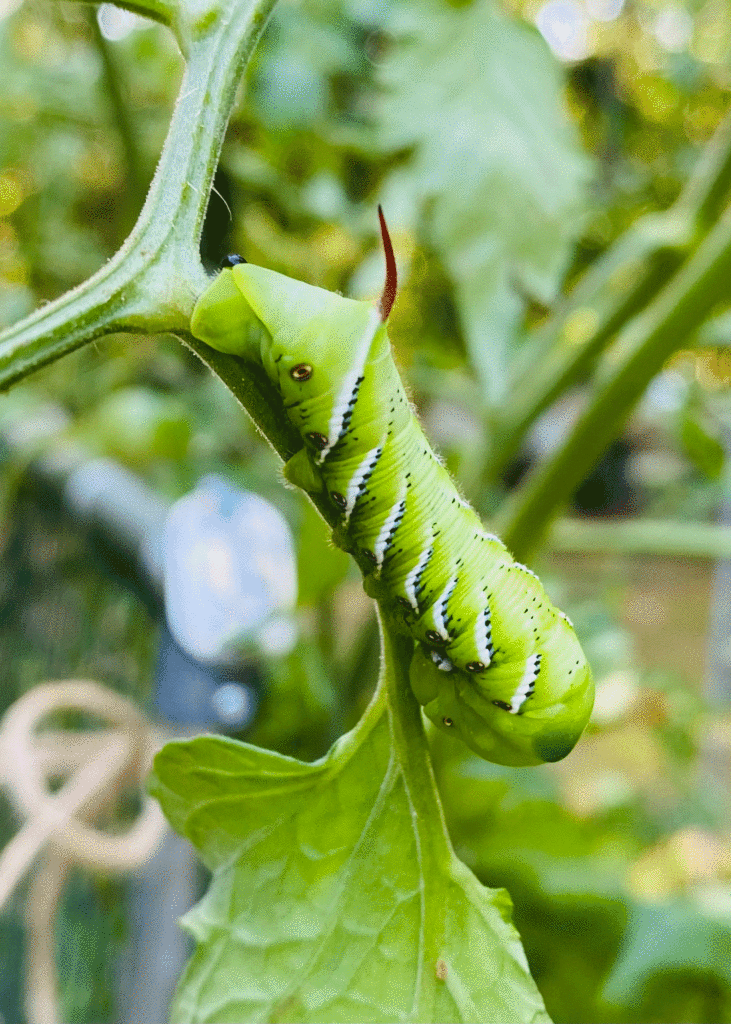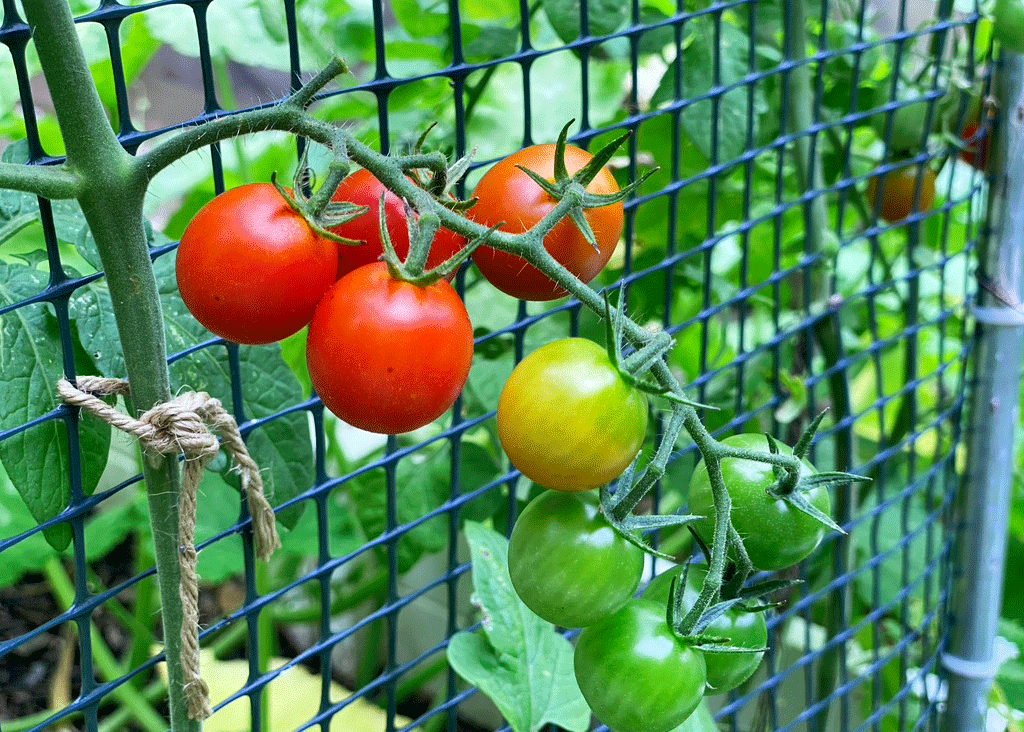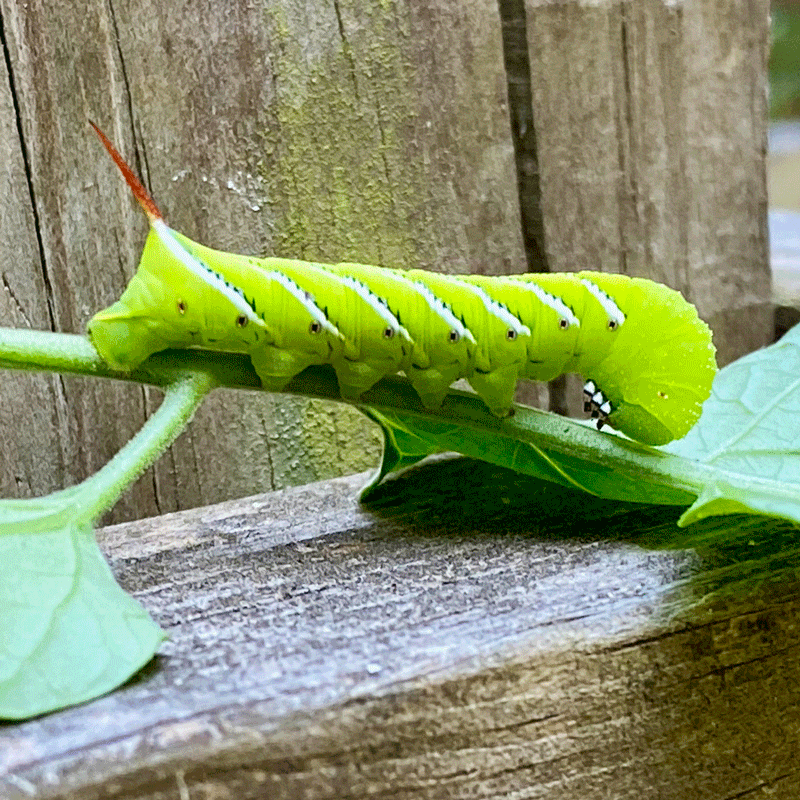In my garden, I call them Evil Tomato Hornworms, with heightened emphasis on the E. I pronounce the name E-vil like Austin Powers describing a mad scientist.
Hornworms are caterpillars that appear just when my tomato vines grow heavy with green fruit. I may be waiting for the sun to do its job and sweeten the harvest, but the hornworm’s mission is to devour as much of my plants as it can. When I check on my plants’ progress in late May to early June, quite often I’ll find the hornworms chomping away on foliage and fruit, from the tip-top of the plant to the base (if they get that far before their gluttony — or my gloves! — catch up with them).
If hornworms didn’t do so much damage to my tomatoes, I might (possibly) find their comical appearance charming, with their chubby chartreuse bodies striped with white chevrons.
Truth be told, as a committed pollinator gardener, I’m learning to live with their appetites and finding ways to manage the little beasts and save my tomato harvest.
Which is Which?
There are two hornworms to look out for in your tomato crops. Tomato hornworms are the larval stage of the five-spotted hawk moth and tobacco hornworms are the larvae of the Carolina sphinx moth. Both are similar in appearance, about the same size, and they appreciate the same host plants. Tomato and tobacco hornworms both eat on the Solanaceae family ~ tomato, pepper, potato, eggplant and various nightshade flowering plants.

How do you tell them apart? The distinguishing feature is the red horn on the tobacco hornworm. That’s what I spy on my tomato plants, so although it’s tempting to call them tomato hornworms, in my garden, they’re tobacco hornworms. In this story, I use the terms interchangeably.
How to Prevent Tomato and Tobacco Hornworm Damage
Once tomato hornworms are in your garden, you’re probably always going to have them because the pupae overwinter in the soil. For this reason, I try to spray tomato vines with Bt (Bacilus thuringiensis) early and often. Bt is an organic product that works by disrupting the caterpillar’s life cycle. Note: It’s not particular to hornworm caterpillars — Bt also kills beneficial caterpillars. Just one reason to be careful when and where you spray. Bt is washed away in rain, so reapply after rainfall.
How to Pick off Tomato and Tobacco Hornworms
Manually picking off the caterpillars is the most effective treatment when they do appear. The hornworms munch from the top-down. In the garden, look to the tops of the vines and scan for evidence of E-vil. Signs like defoliated branches, half-eaten flowers and fruit, and often scat that looks like small black dots.
Train your eyes and when you spy the beast, you have several choices, like:
- With a gloved hand, scoop and drop into a bucket of soapy water.
- With a gloved hand, pick it up and squish it. (not my choice)
- With a gloved hand and a pair of snips, prune off the branch segment with the hornworm and drop the entire piece into a bucket that will be emptied into a trash can. (my choice)
- With a gloved or ungloved hand, move the hornworm to a “sacrifice” plant, so the little guy can complete its life cycle and become a moth.
Option #3 is my go-to choice for this season and I have no regrets. I’m careful to trim branches and not fruit whenever possible. The mid-season pruning is beneficial, too. It opens up the plants and allows air to flow through.
Option #4 is my mid-season hornworm strategy. I accidentally broke a couple large branches from my cherry tomato plant. I stuck the branches in a planter filled with rich, organic soil, and guess what? The branches rooted and are now filled with cherry tomatoes. This pot is about four feet away from my garden, just far enough so that I can remove hornworms and place them on this sacrificial plant.

Plant Ahead for Beneficial Insects
Another strategy: plant ahead to attract beneficial insects that prey on hornworm eggs, like lady beetles and green lacewings. Paper wasps (yay, wasps!) eat hornworm larvae.
Coolest of all hornworm predators are braconid wasps, parisitoids that lay eggs on the hornworm. When the eggs hatch, the larvae eat the hornworm from the inside out. (Insert E-vil mwah-ha-hah)

If you spy a parisitized hornworm in your garden, leave it alone and let the wasps do their job. Your garden’s ecology is strong. Extend your right arm to the sky, bend at the elbow and pat your right shoulder. Good job, gardener!
Plants that attract beneficial insects:
Flowers:
Coreopsis
Cosmos
Goldenrod
Queen Anne’s Lace
Yarrow
Herbs:
Chamomile
Cilantro
Coriander
Dill
More Gardening Stories from A Cook and Her Books
Join the Conversation
Let’s talk about gardening and more on Instagram and Facebook. I’d love to hear from you!



Just for the record, this is a tobacco horn worm because the horn is red. Tomato horn worms have black horns. At least that’s what I’ve read when I did research on mine.